The key is cooking in batches and freezing one-meal portions.
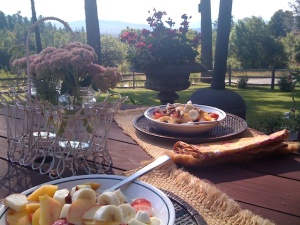
Adirondack Dining at it’s Best. Here’s what my fruit bowl and my Sailors Daily Oatmeal look like when I eat them outdoors.
After being married for almost thirty years, I have now been a single man for fifteen. And during that time, I have learned the most valuable lesson of my life—what we should be eating to promote our health and sustain our planet.
Concurrently, as an Industrial Engineer, I have learned how to efficiently prepare over 75% of the calories that I consume. And all of those meals that I prepare at home are 4Leaf, with over 80% of their calories from whole, plant-based foods.
The key to maintaining a diet-style at the 4Leaf level is to work on perfecting all of your “routine” meals. Those are the meals that you have at least once a week—every week. For me, that’s pretty easy, because I don’t prepare very many different meals at home. I figure if the Tarahumara in Mexico can thrive on corn, squash and beans—then I can thrive on my go-to breakfast, lunch and dinner meals—with some five to ten highly nutritious ingredients in each of them. Here is my schedule:
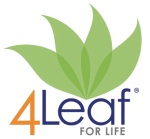
A 4Leaf meal derives over 80% of its calories from whole plants; 3Leaf is over 60% and so forth.
0730 First meal of the day. A bowl of fresh fruit. Depending on season, a combination of orange, pear, berries, banana, mango, melon, kiwi, and/or apples
1100 My Sailors Daily Oatmeal. While my whole grain oats are soaking in a mixture of cold water and unsweetened soy, almond, coconut or rice milk—I cut my fruit to load on top. The fruit varies by season, but the most frequent is blueberries, apple and banana. I never get tired of this meal. As a bonus, the “milks” that I use are often fortified with Vitamin D and B12.
2 p.m. My Sailors Super 4Leaf Lunch. Here’s where I do the batch cooking in advance. About once a week, I cook a batch of wild rice/brown rice and a batch of black beans/red beans. I usually soak both batches overnight before cooking my rice in a rice cooker and my beans in a standard saucepan. The cooking takes about an hour for each. After cooling for a few hours, I load seven single-serve portions of beans and rice in little plastic containers that I can freeze. Here’s how I do it—scroll down through these pictures (Notice the captions below the pics):
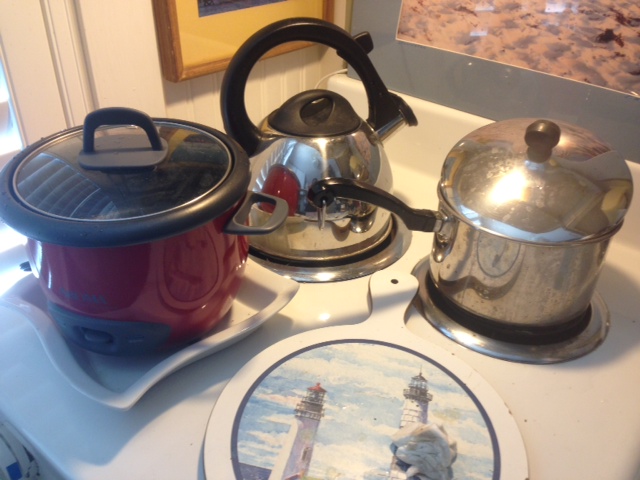
Here’s where I do the soaking and the cooking. Notice the lighthouse for the “Sailors Super 4Leaf Lunch”
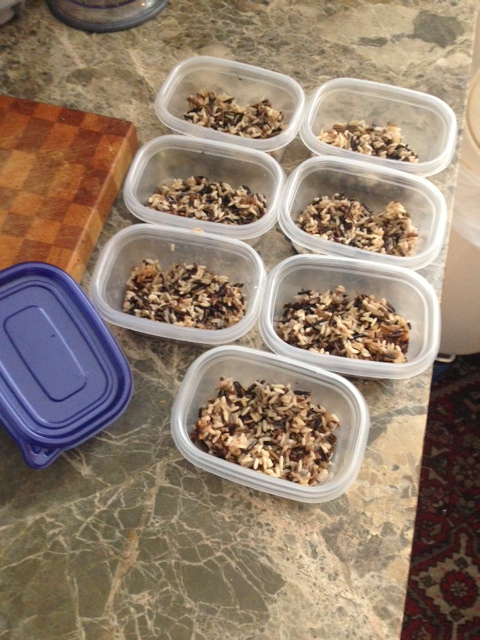
I load the rice mixture into the bottom of the little containers.

Then I load the bean mixture on top.
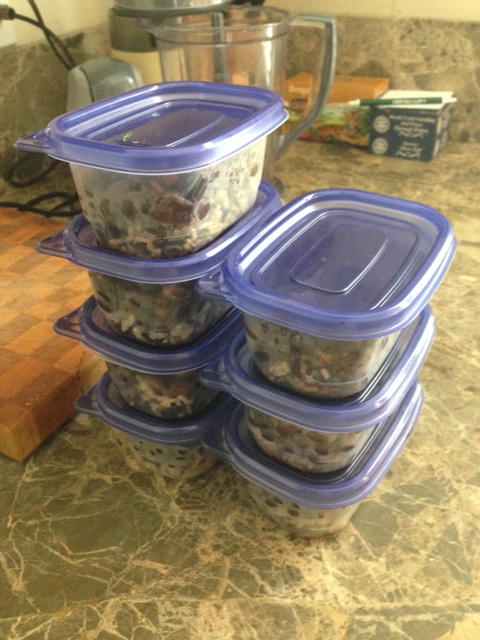
Here are my seven little containers with lids on top—ready to freeze. As for cost, I figure that each container has about 200 calories and costs about 29 cents each.
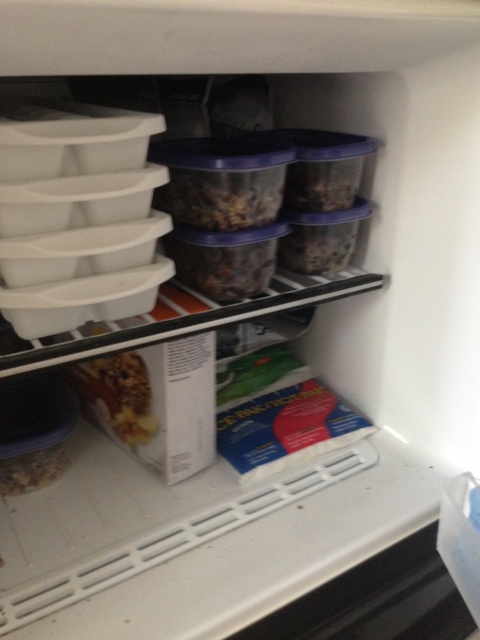
Here they are in the freezer.
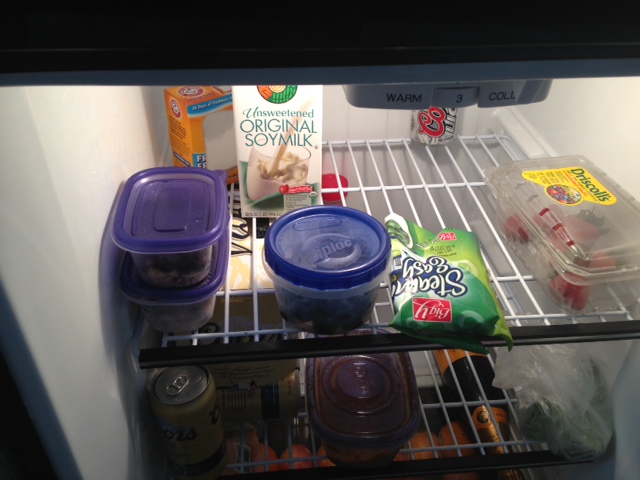
I usually keep two in the refrigerator section so that they’re ready to cook without having to defrost.
Preparing the lunch or dinner. I empty the contents of one of my single serve containers of rice & beans onto the plate—upside down. So now, my rice is on the top and my beans are on the bottom. I then slice up whatever vegetables I want to cook slightly while I warm up the meal—things like broccoli, mushrooms, celery, squash, eggplant, kale, spinach, cauliflower and/or shelled edamame. I then add my Kirkland non-salt seasoning and Braggs Liquid Aminos (spray) along with lime juice—for great flavor every time.
I generally cook for about two minutes in the microwave (I like my veggies raw or just barely cooked). During those two minutes, I slice up things like avocado, tomato, celery and/or carrots (all raw) that I load on top of my meal before serving.
As for timing, the batch cooking method doesn’t take much of my time at all.The total amount of my own time for cooking is about two minutes and the loading of containers and clean-up is about five minutes. That is just once a week—adding up to seven minutes for an average of one minute per meal. Then the actual slicing, heating and serving takes me about five minutes from the time that decide that I am ready to eat.
Final product–a 4Leaf meal with well over 80% of calories from whole plants
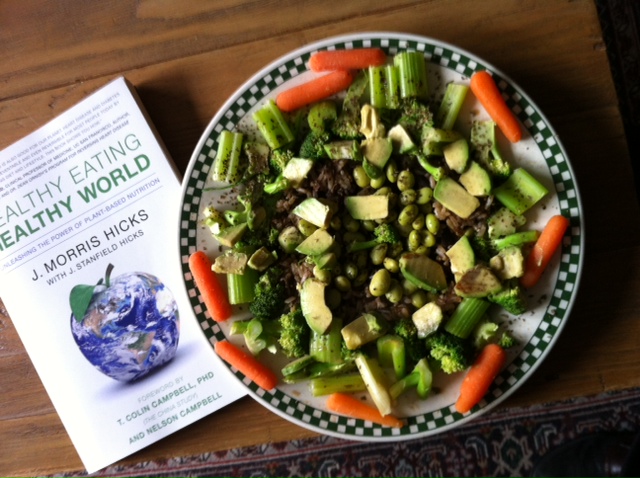
Check out the bright green edamame on top.
A few more handy links to some of my previous blogs on this topic:
- Are microwave ovens safe? Do they destroy nutrients?
- It also doesn’t cost much to eat this way. The Dollars and “Sense” of Plant-Based Eating
- Sailors Daily 4Leaf Oatmeal, originally created by Jim, it remains one of his favorites.
- Sailors Super 4Leaf Lunch (or dinner) two versions one with bread/hummus, one without
- Earlier blog featuring the Tarahumara. In search of the most perfect diet…
Handy 4-piece take-charge-of-your-health kit—from Amazon.com
- The movie that’s changing the lives of millions: Forks Over Knives DVD
- Healthy Eating, Healthy World, The “big picture” about food (our book)
- An essential scientific resource: The China Study by Dr. T. Colin Campbell
- Dr. McDougall’s new book, The Starch Solution, with lots of great recipes.
Want to find out how healthy your family is eating? Take our free 4Leaf Survey. It takes less than five minutes and you can score it yourself. After taking the survey, please give me your feedback as it will be helpful in the development of our future 4Leaf app for smartphones. Send feedback to jmorrishicks@me.com

 International. We’re now reaching people in over 100 countries. Follow us on Facebook and Twitter or get daily blog notices by “following” us in the top of the right-hand column. For occasional updates, join our periodic mailing list.
International. We’re now reaching people in over 100 countries. Follow us on Facebook and Twitter or get daily blog notices by “following” us in the top of the right-hand column. For occasional updates, join our periodic mailing list.
To order more of my favorite books—visit our online BookStore now

J. Morris Hicks, working daily to promote health, hope and harmony on planet Earth.
For help in your own quest to take charge of your health, you might find some useful information at our 4Leaf page or some great recipes at Lisa’s 4Leaf Kitchen.
Got a question? Let me hear from you at jmorrishicks@me.com. Or give me a call on my cell at 917-399-9700.
SHARE and rate this post below.
—J. Morris Hicks, board member, T. Colin Campbell Foundation


Oh boy….where’s the ice cream, cheese..and chocolate??:-)
I love to cook for my husband, family and friends, and nobody would want to sit around my table if that’s all I would offer them! While I admire your goals, I would feel wretched if I had to eat like that for the rest of my life.And my husband would probably leave me.:-)
I belive in eating everything in moderation..
Jim, looks great, rice and beans are a favorite of mine as well.
One thing that’s been on my mind lately, being plant-based, is the renewed attention on the continuing bee colony-collapse disorder (CCD) situation which is very chilling: http://science.time.com/2013/05/07/beepocalypse-redux-honey-bees-are-still-dying-and-we-still-dont-know-why/
Have you written about GMO’s and Monsanto in the past? There are alot of good documentaries on CCD. Big issue for sure, here in California they were able to help prevent the passing of GMO-labeling last year… so sad. Anyway, I think the above article’s closing line says alot to us plant-based folk concerned with superior health:
“So what we may get in Europe and the U.S. is a de facto field test of the real impact of neonicotinoids on CCD. In two years, if American bees are still dying and their European cousins are thriving, we might just have our answers. And if not, well, I hope you don’t like cashews, beets, broccoli, cabbage, brussels sprouts, chestnuts, watermelons, cucumber, fennel, strawberries, macadamia, mangoes, apricots, almonds or any of the other dozens of food crops pollinated by our hardworking, six-legged, unpaid farmworkers.”
Yes, ditto to what JoAnne said! Thanks for the visuals – really helpful! My other trick is to cook a big pot of soup on Sunday which makes enough for lunch all week. If I added your Sailor’s 4 Leaf meal for dinner, I wouldn’t need to spend much time in the kitchen at all.
Great pictorial on how to eat healthy – economically and with fabulous time saving tips. Many tell me that they don’t enjoy cooking. The thought of all that chopping, dicing, and slicing turns them off. Today’s blog gives people helpful tools. By changing the spices and types of beans, you can enjoy different cuisines, as well!! Once again, bravo, Jim!